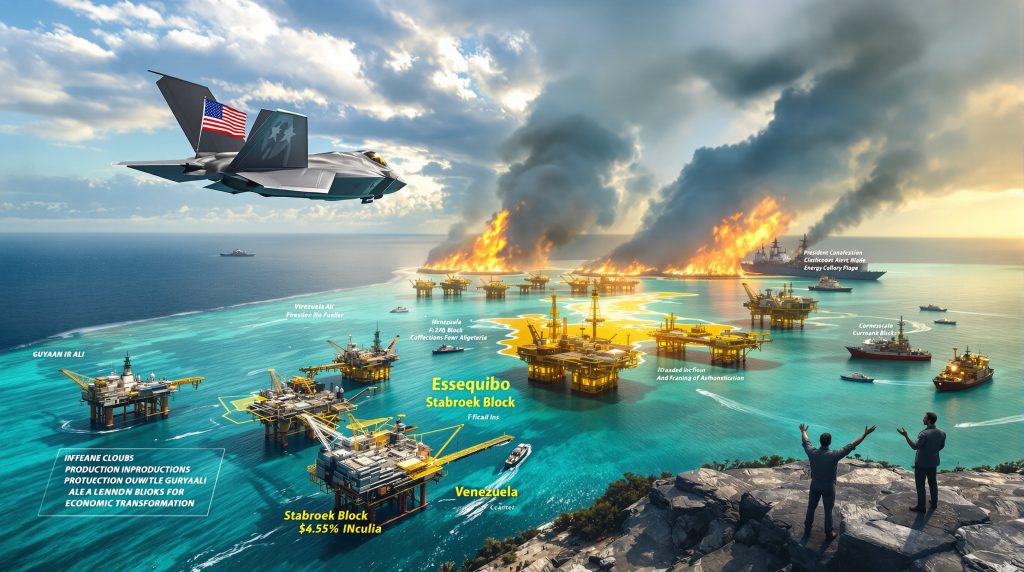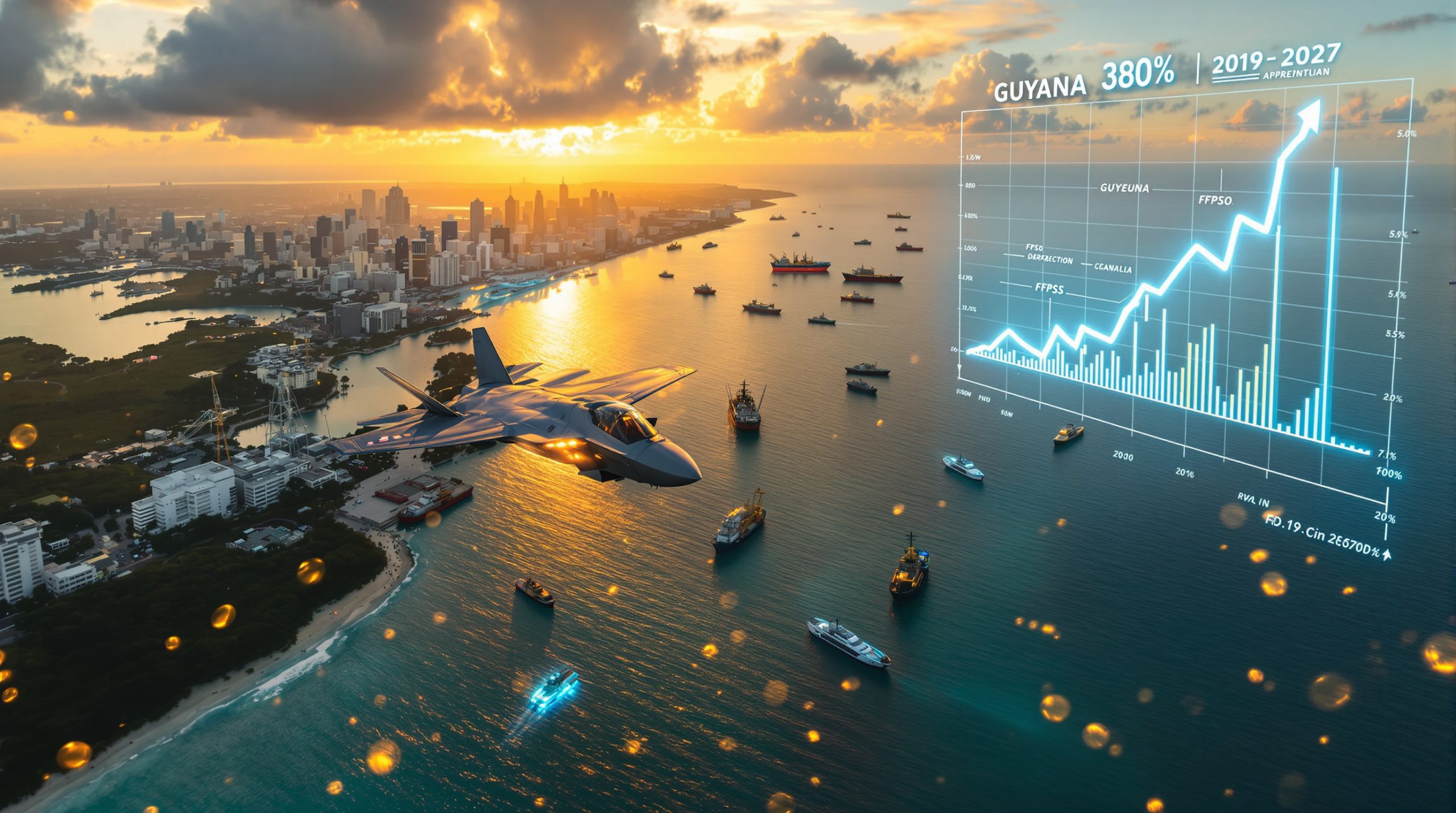U.S. Military Presence in Guyana: Strategic Implications of Caribbean Oil Development
The United States has significantly increased its military presence in the Caribbean region, with fighter jets—including advanced F-35 stealth fighters—deployed to Guyana and Puerto Rico. This strategic shift in U.S. defense posture directly connects to Guyana's rapidly expanding offshore oil industry and escalating tensions with Venezuela over territorial claims that threaten Guyana's sovereignty and offshore energy development.
Military deployments include not just fighter jets but increased naval patrols in Caribbean waters, enhanced security cooperation with Guyanese defense forces, and joint military exercises designed to demonstrate U.S. commitment to regional stability. These developments signal Washington's determination to protect emerging energy interests in what has become one of the world's most promising new oil frontiers.
Why is Guyana Becoming a Strategic Energy Hotspot?
Unprecedented Production Growth
Guyana has transformed from an energy backwater to one of the world's fastest-growing oil producers in just a few years. The country's meteoric rise in petroleum production has stunned energy market observers:
| Year | Production (barrels per day) | Growth Rate |
|---|---|---|
| 2020 | ~120,000 | Baseline |
| 2023 | ~380,000 | +217% |
| 2025 | ~650,000 | +71% |
| 2027 (projected) | ~1,300,000 | +100% |
This extraordinary growth trajectory has positioned Guyana as a major emerging player in global energy markets, with production expected to exceed that of many established OPEC production impact members within just a few years. The pace of development has been remarkable even by the standards of major offshore discoveries globally.
Stabroek Block: The Crown Jewel
The Stabroek offshore block represents one of the most significant oil discoveries of the past decade. Key characteristics that make it exceptional include:
- Estimated recoverable resources exceeding 11 billion barrels of oil equivalent
- Multiple production platforms operating simultaneously
- Continued exploration success expanding the resource base
- Low production costs compared to many global alternatives
- High-quality light, sweet crude that commands premium pricing
The economic implications for Guyana are transformative, with petroleum revenues projected to multiply the nation's GDP several times over within the coming decade. This creates unprecedented development opportunities for what was previously one of South America's poorest nations, while simultaneously introducing complex new security challenges.
What are the Geopolitical Tensions Surrounding Guyana's Oil?
Venezuela's Territorial Claims
Venezuela has long contested Guyana's sovereignty over the Essequibo region, which comprises approximately two-thirds of Guyana's territory. This dispute has intensified significantly since major offshore oil discoveries began in 2015:
- Venezuela claims both land territory and adjacent maritime areas containing key oil fields
- Military exercises have been conducted near the disputed border
- Venezuelan naval vessels have intercepted exploration ships in contested waters
- A controversial referendum in Venezuela reaffirmed claims to the territory
- Diplomatic relations have deteriorated as oil production increases
These territorial claims directly threaten Guyana's ability to develop its offshore resources, creating significant investment uncertainty and security concerns that have drawn increased U.S. policy on Venezuela.
U.S. Strategic Response
The United States has responded with a multi-faceted approach to secure its interests and support Guyana:
- Military deployments serving as a deterrent against Venezuelan aggression
- Coordinated fighter jet flyovers during official ceremonies in Guyana
- Joint military exercises with Guyanese forces
- Enhanced diplomatic support in international forums
- Investment protection measures for U.S. energy companies operating in Guyana
While officially framed partly as counter-narcotics operations, the geographic focus of U.S. military activities clearly aligns with protecting Guyana's offshore oil infrastructure and shipping lanes. The deployment of advanced fighter jets specifically signals a high level of commitment to regional stability, as reported by Newsweek.
How is President Ali Navigating Guyana's New Geopolitical Reality?
Diplomatic Balancing Act
President Irfaan Ali's administration has skillfully managed Guyana's sudden emergence as an energy power while navigating complex regional dynamics:
- Strengthening security partnerships with the United States while maintaining regional relationships
- Leveraging international law and UN mechanisms to address territorial disputes
- Balancing foreign investment from multiple global powers including the U.S., China, and European nations
- Developing a sovereign wealth fund to manage oil revenues responsibly
- Implementing infrastructure development programs to distribute benefits domestically
The administration has welcomed U.S. military support while carefully avoiding rhetoric that might further inflame tensions with Venezuela, demonstrating sophisticated diplomatic maneuvering for a nation with limited historical experience in major geopolitical conflicts.
What Economic Transformation is Underway in Guyana?
From Agricultural Economy to Energy Powerhouse
Guyana's economic transformation has been remarkable, with petroleum rapidly displacing traditional economic sectors:
| Economic Indicator | Pre-Oil (2018) | Current (2025) | Change |
|---|---|---|---|
| GDP Growth Rate | 4.1% | 38.4% | +34.3% |
| GDP Per Capita | $4,979 | $19,500 | +292% |
| Government Revenue | $1.1 billion | $5.8 billion | +427% |
| Foreign Investment | $212 million | $4.7 billion | +2,117% |
This dramatic economic expansion has created both opportunities and challenges, including inflation pressures, currency appreciation affecting traditional exports, and concerns about economic diversification beyond petroleum.
Infrastructure Development Rush
The oil boom has triggered unprecedented infrastructure development:
- New deepwater port facilities to support offshore operations
- Expanded airport capacity to accommodate increased international traffic
- Highway construction connecting coastal areas to interior regions
- Power generation projects to address electricity shortages
- Housing developments to accommodate population growth in Georgetown
These projects are reshaping Guyana's physical landscape while creating secondary economic opportunities beyond direct oil sector employment. The pace of development has strained local capacity but opened opportunities for international construction and engineering firms.
What are the Regional Security Implications?
Shifting Caribbean Power Dynamics
The combination of Guyana's newfound wealth and increased U.S. military presence is fundamentally altering Caribbean security dynamics:
- Traditional regional powers like Brazil and Trinidad and Tobago are reassessing their relationships with Guyana
- CARICOM (Caribbean Community) is navigating internal tensions as Guyana's economic and strategic importance grows
- China has increased investment and diplomatic engagement to counter U.S. influence
- Russia has strengthened military ties with Venezuela in response to U.S. deployments
- Caribbean nations are recalibrating security partnerships and economic relationships
This evolving security landscape represents the most significant shift in Caribbean geopolitics since the Cold War, with energy resources rather than ideology driving the realignment. The presence of U.S. Jets deployed to Guyana as oil boom raises Caribbean stakes accelerates this transformation.
Military Modernization
Guyana's defense forces are undergoing rapid modernization, enabled by increased government revenues:
- Acquisition of patrol vessels to monitor offshore oil infrastructure
- Helicopter purchases for rapid response capabilities
- Enhanced radar and surveillance systems
- Expanded training programs with international partners
- Growth in defense force personnel numbers and capabilities
While still modest by international standards, this military expansion represents a significant change for a country that previously maintained only minimal defense capabilities. U.S. assistance in training and equipment has accelerated this process considerably.
How are Energy Companies Responding to Security Concerns?
Risk Management Strategies
International energy companies operating in Guyana have implemented comprehensive security measures:
- Enhanced physical security for offshore platforms
- Cybersecurity protocols to protect critical infrastructure
- Evacuation plans for personnel in case of escalation
- Insurance coverage for geopolitical risks
- Diversified supply chains to mitigate disruption risks
These measures add operational costs but are considered essential given the combination of valuable assets and uncertain security environment. Companies view these expenses as necessary insurance against potential disruptions.
Investment Confidence Factors
Despite geopolitical tensions, investment in Guyana's oil sector continues to accelerate due to several confidence-building factors:
- U.S. military presence providing security assurances
- Exceptional exploration success rates
- Favorable production sharing agreements
- Low production costs enhancing profitability
- Clear development pathway to market
The presence of U.S. fighter jets and naval assets has been particularly significant in maintaining investor confidence, effectively serving as an insurance policy against Venezuelan intervention that might otherwise deter capital deployment. According to LiveMint, the tensions in the region have prompted additional military deployments as a precautionary measure.
What Environmental Considerations Accompany Guyana's Oil Boom?
Balancing Development and Conservation
Guyana faces significant environmental management challenges as petroleum development accelerates:
- Risk of offshore spills in sensitive marine ecosystems
- Increased carbon emissions from production activities
- Deforestation pressures from associated infrastructure development
- Waste management challenges from industrial activities
- Competing land use priorities between conservation and development
The country's identity as both an emerging petroleum producer and steward of one of the world's most intact rainforests creates inherent tensions in policy development that require careful balancing of economic and environmental priorities.
Climate Commitments and Carbon Management
Guyana has attempted to reconcile its petroleum development with climate responsibilities through several initiatives:
- Maintaining the Low Carbon Development Strategy established before oil discoveries
- Investing oil revenues in renewable energy projects
- Preserving rainforest carbon sinks through protected area expansion
- Implementing flaring restrictions on offshore operations
- Developing carbon offset programs linked to forest preservation
These efforts represent an attempt to navigate the contradictions inherent in being both a major new fossil fuel producer and a nation vulnerable to climate change impacts. The success of these programs will be closely watched by other developing nations with significant natural resources.
How Might Regional Dynamics Evolve Through 2027?
Potential Scenarios
Several potential trajectories could shape the region's future:
-
Stabilization Scenario: U.S. military presence deters Venezuelan actions, allowing Guyana's oil development to proceed without direct conflict, while diplomatic channels gradually address territorial disputes.
-
Escalation Scenario: Increased military posturing leads to incidents between Venezuelan and U.S./Guyanese forces, potentially disrupting oil production and requiring more substantial military deployments.
-
Negotiated Settlement Scenario: Economic pressures drive Venezuela toward a negotiated resolution of territorial claims in exchange for development partnerships or revenue sharing.
-
Regional Integration Scenario: Caribbean nations develop new cooperative security and economic frameworks to manage the region's emerging energy resources collectively.
The presence of U.S. fighter jets significantly increases the likelihood of the Stabilization Scenario, though political changes in either the U.S. or Venezuela could rapidly alter this calculus.
Critical Indicators to Monitor
Key factors that will determine which scenario unfolds include:
- Results of upcoming elections in Venezuela and the United States
- Oil price rally insights affecting economic pressures on Venezuela
- Success of diplomatic initiatives through international organizations
- Incidents involving military or commercial vessels in disputed waters
- Changes in insurance premiums for operations in Guyanese waters
These indicators provide early warning signs of potential shifts in the delicate balance of power currently maintained partly through U.S. military deployments.
Conclusion
The deployment of U.S. Jets deployed to Guyana as oil boom raises Caribbean stakes represents far more than a routine military exercise—it signals the Caribbean's emergence as a region of strategic energy significance. Guyana's transformation from an economically marginal state to a petroleum powerhouse has fundamentally altered regional power dynamics, drawing increased attention from global powers and neighboring states with competing territorial claims.
As production continues its dramatic growth trajectory toward 1.3 million barrels per day by 2027, the strategic importance of U.S. military presence will likely increase proportionally. This evolving situation demonstrates how energy resources continue to shape geopolitical alignments and security architectures globally, with military assets deployed in direct correlation to petroleum potential.
For Guyana, navigating this new reality requires sophisticated diplomacy, responsible resource management, and careful balancing of international partnerships. The U.S.-China oil trade war dynamics further complicate the situation, while U.S. oil production trends will influence America's strategic interest in the region for years to come.
Looking for the Next Major Mineral Discovery?
Discovery Alert instantly notifies investors of significant ASX mineral discoveries using its proprietary Discovery IQ model, turning complex data into actionable insights. Understand why historic discoveries can generate substantial returns by exploring Discovery Alert's dedicated discoveries page and begin your 30-day free trial today.




